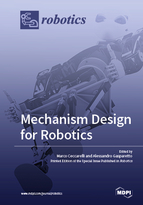Mechanism Design for Robotics
A special issue of Robotics (ISSN 2218-6581).
Deadline for manuscript submissions: closed (20 January 2019) | Viewed by 110579
Special Issue Editors
Interests: mechanism design mechanics of robots; robot design
Special Issues, Collections and Topics in MDPI journals
Interests: robotics; trajectory planning; modeling of mechatronic systems
Special Issues, Collections and Topics in MDPI journals
Special Issue Information
Dear Colleagues,
Robotics is developing at a much faster pace than ever in the past. In a few years, the scenario will be totally different, both inside and outside of the industrial environment. In order to keep up with this quick evolution, research fields connected with mechanism design and, more generally, to the mechanical modelling of robots and of mechatronics systems, should evolve rapidly.
This Special Issue aims at exhibiting the latest research achievements, findings, and ideas in the areas of “Mechanism Design for Robotics”. The issue will contain revised and substantially extended versions of selected papers that were presented at the 4th IFToMM Symposium on Mechanism Design for Robotics (MEDER 2018), but we also strongly encourage researchers unable to participate in the conference to submit articles for this call.
Papers are welcomed on topics that are related to mechanisms within the aspects of theory, design, practice, and applications for robotics, including, but not limited to:
- theoretical and computational kinematics
- mechanism design
- experimental mechanics
- mechanics of robots
- dynamics of machinery and multi-body systems
- control issues of mechanical systems
- innovative mechanisms and applications
- linkages and manipulators
- micro-mechanisms
- machine intelligence
- mechanism education and history of MMS
Prof. Dr. Marco Ceccarelli
Prof. Dr. Alessandro Gasparetto
Guest Editors
Manuscript Submission Information
Manuscripts should be submitted online at www.mdpi.com by registering and logging in to this website. Once you are registered, click here to go to the submission form. Manuscripts can be submitted until the deadline. All submissions that pass pre-check are peer-reviewed. Accepted papers will be published continuously in the journal (as soon as accepted) and will be listed together on the special issue website. Research articles, review articles as well as short communications are invited. For planned papers, a title and short abstract (about 100 words) can be sent to the Editorial Office for announcement on this website.
Submitted manuscripts should not have been published previously, nor be under consideration for publication elsewhere (except conference proceedings papers). All manuscripts are thoroughly refereed through a single-blind peer-review process. A guide for authors and other relevant information for submission of manuscripts is available on the Instructions for Authors page. Robotics is an international peer-reviewed open access monthly journal published by MDPI.
Please visit the Instructions for Authors page before submitting a manuscript. The Article Processing Charge (APC) for publication in this open access journal is 1800 CHF (Swiss Francs). Submitted papers should be well formatted and use good English. Authors may use MDPI's English editing service prior to publication or during author revisions.







